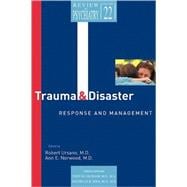
Note: Supplemental materials are not guaranteed with Rental or Used book purchases.
Purchase Benefits
What is included with this book?
Robert J. Ursano, M.D., is Professor and Chairman in the Department of Psychiatry at F. Herbert School of Medicine of Uniformed Services University of the Health Sciences in Bethesda, Maryland.
Ann E. Norwood, M.D., is Associate Professor and Associate Chair in the Department of Psychiatry at F. Herbert School of Medicine of Uniformed Services University of the Health Sciences in Bethesda, Maryland.
| Contributors | ix | ||||
| Introduction to the Review of Psychiatry Series | xiii | ||||
|
|||||
|
|||||
| Preface | xvii | ||||
|
|||||
|
|||||
|
1 | (36) | |||
|
|||||
|
|||||
|
|||||
|
1 | (3) | |||
|
4 | (11) | |||
|
15 | (15) | |||
|
30 | (1) | |||
|
30 | (7) | |||
|
37 | (26) | |||
|
|||||
|
37 | (5) | |||
|
42 | (7) | |||
|
49 | (2) | |||
|
51 | (1) | |||
|
52 | (1) | |||
|
53 | (2) | |||
|
55 | (8) | |||
|
63 | (34) | |||
|
|||||
|
|||||
|
65 | (3) | |||
|
68 | (4) | |||
|
72 | (6) | |||
|
78 | (2) | |||
|
80 | (7) | |||
|
87 | (3) | |||
|
90 | (7) | |||
|
97 | (28) | |||
|
|||||
|
|||||
|
|||||
|
|||||
|
|||||
|
|||||
|
98 | (4) | |||
|
102 | (2) | |||
|
104 | (1) | |||
|
105 | (4) | |||
|
109 | (3) | |||
|
112 | (1) | |||
|
112 | (1) | |||
|
113 | (1) | |||
|
114 | (2) | |||
|
116 | (3) | |||
|
119 | (6) | |||
|
125 | (30) | |||
|
|||||
|
|||||
|
|||||
|
|||||
|
|||||
|
126 | (1) | |||
|
127 | (1) | |||
|
128 | (10) | |||
|
138 | (2) | |||
|
140 | (5) | |||
|
145 | (2) | |||
|
147 | (3) | |||
|
150 | (1) | |||
|
151 | (4) | |||
| Index | 155 |
The New copy of this book will include any supplemental materials advertised. Please check the title of the book to determine if it should include any access cards, study guides, lab manuals, CDs, etc.
The Used, Rental and eBook copies of this book are not guaranteed to include any supplemental materials. Typically, only the book itself is included. This is true even if the title states it includes any access cards, study guides, lab manuals, CDs, etc.